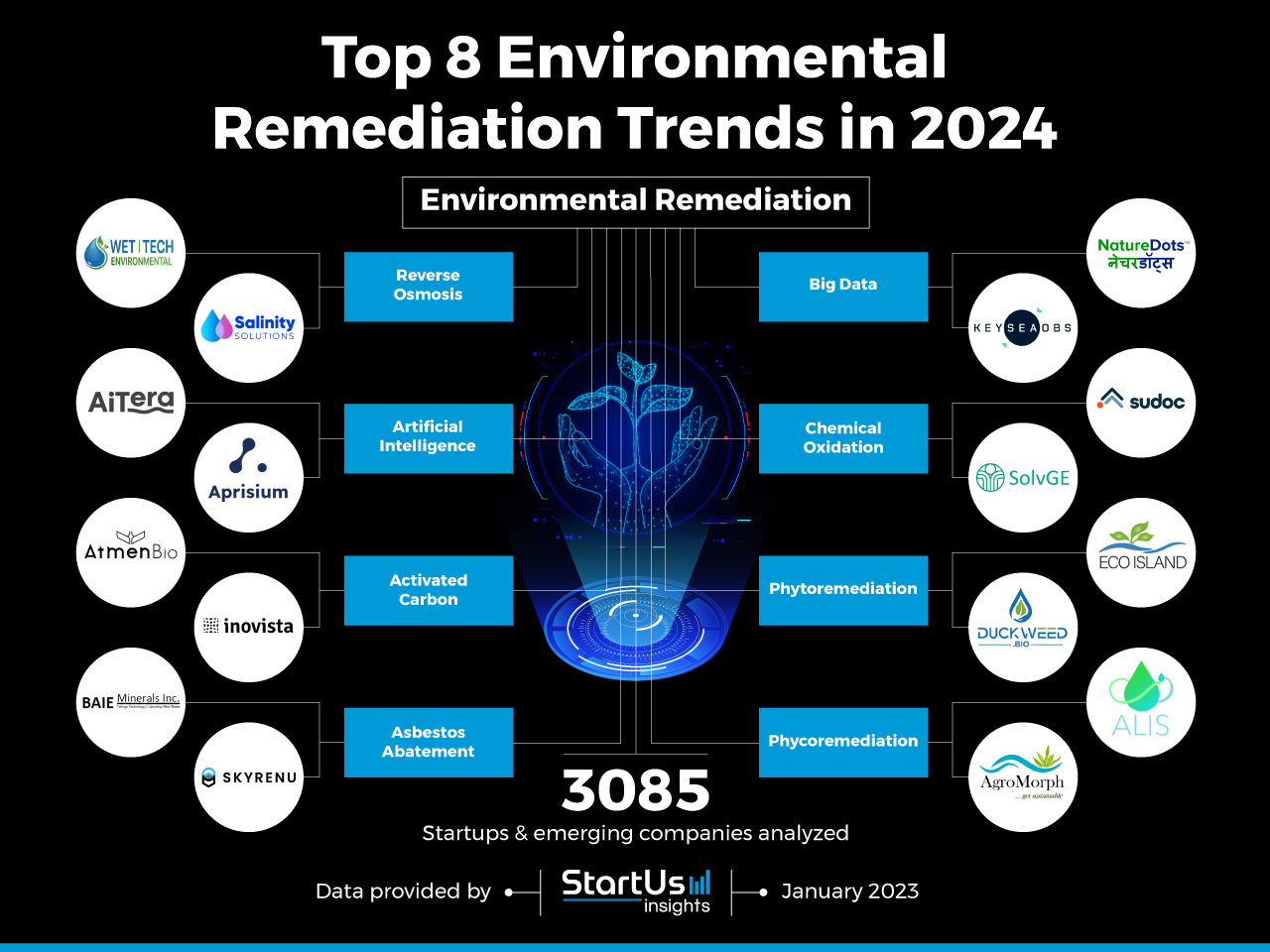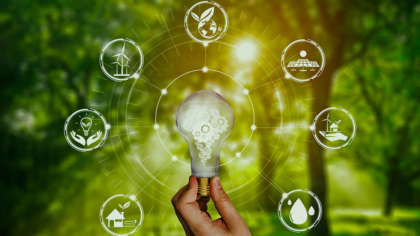Accelerate Productivity in 2025
Reignite Growth Despite the Global Slowdown
Environmental remediation methods remove contaminants generated due to diverse industrial activities. These means include purifying contaminated water, rehabilitating impacted environmental health, and more. Recent trends in environmental remediation highlight a shift towards sustainable and effective contamination and pollution removal strategies. Advancements in technologies like reverse osmosis (RO) and artificial intelligence (AI), along with methods such as phytoremediation and chemical oxidation, are reshaping remediation approaches.
Top 8 Environmental Remediation Trends in 2024
- Reverse Osmosis
- Artificial Intelligence
- Activated Carbon
- Asbestos Abatement
- Big Data
- Chemical Oxidation
- Phytoremediation
- Phycoremediation
Innovation Map outlines the Top 8 Environmental Remediation Trends & 16 Promising Startups
For this in-depth research on the Top Trends in Environmental Remediation, we analyzed a sample of 3085 global startups & scaleups. This data-driven research provides innovation intelligence that helps you improve strategic decision-making by giving you an overview of emerging technologies in the environmental remediation industry. In the Environmental Remediation Innovation Map, you get a comprehensive overview of the innovation trends & startups that impact your company.
These insights are derived by working with our Big Data & Artificial Intelligence-powered StartUs Insights Discovery Platform, covering 3 790 000+ startups & scaleups globally. As the world’s largest resource for data on emerging companies, the SaaS platform enables you to identify relevant technologies and industry trends quickly & exhaustively.
Tree Map reveals the Impact of the Top 8 Environmental Remediation Trends in 2024
Based on the Environmental Remediation Innovation Map, the Tree Map below illustrates the impact of the Top 8 Environmental Remediation Industry Trends in 2024. Amid escalating waste and emissions, industries use reverse osmosis as well as other bioremediation methods to purify wastewater before discharging it to natural water bodies. Additionally, activated carbon’s pollutant absorption enhances real-time response to environmental hazards. Companies are working on innovative means to improve asbestos abatement as well.
Big data serves as the backbone, offering a comprehensive analysis across these trends, while AI forecasts contamination trends to inform and optimize remediation strategies. At the same time, chemical oxidation directly neutralizes contaminants for remediation. Phytoremediation and phycoremediation collectively signify the growing interest in biological approach to remediation. These trends form a cohesive framework to push the boundaries of traditional environmental remediation approaches.
Global Startup Heat Map covers 3085 Environmental Remediation Startups & Scaleups
The Global Startup Heat Map below highlights the global distribution of the 3085 exemplary startups & scaleups that we analyzed for this research. Created through the StartUs Insights Discovery Platform, the Heat Map reveals high startup activity in the US and the UK.
Below, you get to meet 16 out of these 3085 promising startups & scaleups as well as the solutions they develop. These environmental remediation startups are hand-picked based on criteria such as founding year, location, funding raised & more. Depending on your specific needs, your top picks might look entirely different.
Interested in exploring all 3000+ environmental remediation startups & scaleups?
1. Reverse Osmosis
RO technology uses semi-permeable membranes to filter out contaminants like salts, heavy metals, microorganisms, and organic compounds from water. Advancements in RO enhance membrane efficiency and durability. For example, membranes incorporating nanomaterials offer improved filtration capabilities to remove even the smallest contaminants.
Such improvements expand RO’s role in environmental remediation, making it effective in treating industrial wastewater and removing specific contaminants. Innovations like low-pressure membranes and energy recovery devices also reduce the energy consumption of RO systems. This improves their sustainability and applicability in diverse environmental scenarios.
Wet Tech Environmental develops Membrane Technology for Water Treatment
Canadian startup Wet Tech Environmental specializes in advanced membrane technology for water treatment. The startup’s technology optimizes the flow and rejection of constituents in liquids and gasses. It offers an effective mechanical separation process that minimizes the use of chemicals and energy.
Wet Tech addresses the common issue of membrane plugging by treating wastewater before it reaches the membranes, using biological treatment and filtration media. This solution is beneficial to municipalities, industrial and commercial companies, and sectors like mining, food, and beverage.
Salinity Solutions uses Sealed Loop Reverse Osmosis Technology
UK-based startup Salinity Solutions utilizes RO technology for its SAM50 system. It recirculates feedwater around the membrane for higher recovery in a smaller footprint and features a patented pressure exchange process that significantly reduces energy consumption.
The company’s technology benefits industrial applications in water reuse, ultrapure water production, mineral extraction, brine minimization, and effluent treatment. Salinity Solutions’ recent trial collaboration with Cornish Lithium tested the system’s capabilities, successfully concentrating lithium from shallow-well geothermal waters in Cornwall.
2. Artificial Intelligence
AI algorithms analyze extensive environmental data from satellite imagery, sensor networks, and more to detect pollution trends and forecast future contamination. This enables industry professionals to plan targeted and efficient remediation strategies, significantly improving response times and effectiveness.
For instance, AI models predict oil spill trajectories to guide quick and effective clean-up. Further, AI optimizes remediation processes based on environmental feedback to adapt strategies in real time. This adaptability is crucial for complex, dynamic environmental systems. AI also streamlines resource allocation in remediation projects, balancing efficiency with cost-effectiveness.
AITera specializes in AI-powered Decontamination
Canada-based startup AITera provides artificial intelligence-driven solutions for soil and groundwater decontamination. Its AI tool utilizes a vast database of research articles, environmental reports, and decontamination cases to conduct advanced multi-criteria analyses of treatment methods.
The tool also employs automated natural language processing (NLP) to tailor solutions for specific decontamination projects. Benefiting environmental remediation experts, AITera’s approach reduces the risks, delays, and costs associated with soil and groundwater decontamination.
Aprisium simplifies Contaminant Management
Singapore-based startup Aprisium detects and monitors rapid on-site contaminants using AI analytics and live online dashboards. The startup offers 4 core technologies. Aprisium Acuitas leverages big data for AI-driven predictive and prescriptive analysis; Aprisium Quadro for manual batch testing of heavy metals, pesticides, and pathogens; Aprisium Continuum for automated, real-time detection of water quality parameters; and Aprisium Spectra for testing non-ionizing contaminants in various substances. These technologies provide comprehensive, customizable contaminant detection solutions for industrial wastewater, data centers, electric vehicles and battery plants, and biofuel sectors.
3. Activated Carbon
Activated carbon absorbs pollutants such as organic compounds, heavy metals, and toxins, due to its large surface area and porous structure. Recent innovations include modified or engineered activated carbons with enhanced adsorption capabilities and selectivity for specific contaminants. This happens through surface treatment or incorporating nanomaterials, making the carbon more efficient in capturing a wider range of pollutants.
These advances expand the application of activated carbon in treating industrial effluents, remediating contaminated groundwater, and purifying air in industrial and urban settings. By effectively removing pollutants, activated carbon technology plays a crucial role in maintaining environmental quality and public health.
AtmenBio offers a Single-Pass Dental Air Filtration Unit
US-based startup AtmenBio develops BioAblate – DX1, a dental filtration system with proprietary air purification technology. The system combines hospital-grade HEPA air filtration, a vacuum-UV reaction chamber, and a carbon filter. It also uses high-energy photons and ozone to eliminate airborne pathogens, including bacteria and viruses, in a single pass.
The startup’s process effectively denatures viruses, removes VOCs, mold spores, and odors, as well as enables rapid room purification. Benefiting medical facilities, BioAblate – DX1 significantly reduces the transmission of airborne pathogens.
Inovista produces Biomass-based Air Purification
Turkish startup Inovista utilizes activated carbon from biomass for air purification. Its technology utilizes activated carbon to improve processes like vapor and solvent recovery, odor control, and biogas purification. Inovista’s technology thus benefits industries and communities seeking eco-friendly air quality improvement solutions.
4. Asbestos Abatement
Asbestos abatement eliminates or reduces the impact of materials containing asbestos within buildings or structures. This naturally occurring mineral fiber, previously common in construction materials like insulation, roofing, and flooring, is a recognized carcinogen. Exposure to asbestos fibers is linked to severe health issues, including asbestosis, lung cancer, and mesothelioma.
Technological advances in this field include advanced air filtration systems to capture asbestos fibers and innovative encapsulation methods that seal asbestos. Additionally, new techniques for asbestos identification and assessment increase the accuracy and safety of abatement processes. One of these techniques includes treating harmful asbestos with carbon dioxide, thereby reducing CO2 levels as well.
Baie Minerals aids in Mine Waste Detoxification
Canadian startup Baie Minerals repurposes abandoned asbestos mine tailings in Baie Verte, Newfoundland. Its technology detoxifies tailings for use in net-zero carbon markets, employing carbon mineralization for CO2 sequestration and extracting industrial minerals.
This process eliminates toxic waste from mine sites and captures CO2, transforming hazardous locations into environmentally safe areas. Communities and industries using Baie Minerals’ solution benefit from both environmental restoration and the advancement of net-zero carbon initiatives.
Skyrenu provides Carbon Capture and Sequestration Technologies
Canadian startup Skyrenu focuses on asbestos abatement by developing a modular system for direct-air-capture (DAC) of CO2. This system, installed in abandoned asbestos mine sites, features a device that captures atmospheric CO2 and uses it for on-site carbonation of mine waste.
The process involves a low-temperature reaction of metals in asbestos with CO2, creating stable carbonates. Beneficiaries of this technology include the environmental management industry dealing with mining and industrial residues, as it offers sustainable and reliable CO2 sequestration.

5. Big Data
Big data enables the collection and analysis of extensive environmental data, such as soil and water quality, pollutant concentrations, and historical contamination records. This data informs strategic decisions about remediation methods, allowing for proactive measures to prevent further environmental damage. For example, predictive models forecast contamination spread and impact to ensure timely and effective intervention.
The technology also streamlines remediation processes by optimizing cleanup strategies, resource allocation, and technology choices, making these efforts cost-effective and efficient. Continuous monitoring of sites provides real-time feedback, crucial for evaluating and adjusting remediation strategies. Moreover, big data ensures accurate reporting to support compliance with environmental regulations as well as aids research and development in the field.
NatureDots provides AI-Powered Ecosystem Analysis
Indian startup NatureDots creates AquaNurch, its AI-powered system that analyzes aquatic ecosystems. It combines IoT and geospatial analysis to monitor water parameters, with units functioning as neural nodes that gather data from various depths and surfaces of water bodies. Proprietary AI models then process this data to provide a detailed ecological analysis.
AquaNurch serves as a comprehensive resource for understanding and forecasting water health across different geographical scales. Environmental agencies and fisheries use this information to maintain healthy water ecosystems, ensure food and protein security, and preserve biodiversity. Additionally, the system offers targeted insights on water pollution and assists in forecasting climate and weather scenarios, contributing to informed environment-first decision-making.
Keyseaobs supports Marine Protected Areas (MPAs)
French startup Keyseaobs specializes in software for marine protected areas deployment. Its technology integrates a data lake that cross-references marine ecosystem and maritime activity data using big data for reliable and comprehensive analysis.
The platform features interactive geospatial tools and analytical widgets to extract insights for maritime environmental management. Marine authorities and environmental planners benefit from it by identifying conflicts and synergies in both activity-environment and activity-activity scenarios quickly. This enables a systemic approach to marine space management.
6. Chemical Oxidation
Chemical oxidation offers a strategic in-situ remediation approach to target soil and groundwater contaminants through direct subsurface treatment. Utilizing oxidants such as potassium permanganate or sodium persulphate, this method effectively degrades pollutants into benign by-products. Consequently, such methods optimize the remediation process while minimizing site disruption.
Chemical oxidation methods also ensure contaminant breakdown and streamline conditions for subsequent aerobic bioremediation. Its application relies on site-specific contaminant profiles and geochemical conditions, offering a tailored solution in complex environmental remediation scenarios.
Sudoc manufactures Cleaning Products and Water Treatment Solutions
US-based startup Sudoc develops solutions using TAML molecules for applications in cleaning products and water treatment. These molecules pair with common oxidants to capture oxygen atoms and oxidize various substances. They emulate peroxidase enzyme actions found in nature. After their use, TAML molecules break down into natural elements, minimizing environmental impact.
Sudoc’s technology benefits multiple sectors, including mold stain removal, waste pharmaceutical management, household cleaning, and wastewater treatment. It also aids oil sand processing, pesticide treatment, municipal water purification, agricultural wastewater management, and mine tailing pond treatment.
SolvGE produces Electrified and Safe Hydrogen Peroxide Concentrator
Netherlands-based startup SolvGE develops a patented technology for on-site production of hydrogen peroxide (H2O2) concentrations. Its Electrified Hydrogen Peroxide Concentrator generates H2O2 at up to 99.5% concentration through a passive method, ensuring both the safety and high purity of the product.
The technology effectively addresses the challenges of storing and transporting high-concentration H2O2, which is crucial for clean and green energy applications. Beneficiaries of SolvGE’s innovation include wastewater treatment plants, and companies in the mining, paper bleaching, electronics manufacturing, and chemical synthesis industries.
7. Phytoremediation
Traditional remediation means often involves cost-intensive processes like excavation or chemical treatments. Recent advances in phytoremediation, like genetically modified plants, greatly enhance the efficiency in absorbing and degrading heavy metals, pesticides, hydrocarbons, and more. This is pivotal for sites with low-to-moderate contamination levels where conventional methods may be excessive or financially unviable.
Further, the exploration of plant-microbe synergies leads to more effective degradation of pollutants, presenting a more holistic approach to remediation. The natural, less intrusive nature of phytoremediation offers cost savings and also aligns with the growing demand for environmentally friendly remediation strategies. This makes phytoremediation a valuable asset in the B2B environmental remediation sector, addressing both ecological and economic concerns.
Eco Island offers Hydroponics-based Water Purification
Denmark-based startup Eco Island develops nature-based hydroponic systems for water purification, utilizing phytoremediation techniques. It leverages plants and microbial interactions on floating islands to remove and neutralize contaminants from water bodies, aiding processes like denitrification and sedimentation.
Eco Island offers solutions for sustainable and effective water treatment, ecosystem restoration, cloudburst mitigation, and erosion control. This contributies to healthier water ecosystems and enhanced environmental sustainability. Beneficiaries of Eco Island’s technology include environmental management sectors and communities requiring water purification and ecosystem restoration.
Duckweed Biotech develops Sustainable Organic Biostimulants
US-based startup Duckweed Biotech produces organic, biological, and non-GMO organisms in ecologically safe systems. The startup focuses on reducing carbon footprints and sequestering greenhouse gasses through its proprietary hydroponics, which simultaneously cleans water via phytoremediation. It also develops a sustainable organic biostimulant fertilizer to increase crop yields while purifying surface water.
Further, the startup is working on high-nutrient-value feed solutions as a substitute for traditional feeds like full-fat soybean meal, fishmeal, or alfalfa. Duckweed Bio’s products cater to the agriculture sector by providing organic, non-GMO feed for cattle, poultry, and aquaculture industries.
8. Phycoremediation
Phycoremediation refers to the utilization of algae to cleanse contaminated water or wastewater. Algae thrive under varying nutrient conditions, making them an effective tool for bioremediation. Using algae to process wastewater produces cleaner water and usable biomass that become raw materials for various products like food, animal feed, fertilizer, drugs, or even biofuels.
Through photosynthesis, algae absorb carbon dioxide and decrease greenhouse gas emissions while simultaneously treating wastewater. Additionally, microalgae possess the capacity to eliminate harmful substances found in wastewater, such as heavy metals, hydrocarbons, and pesticides, via processes like biosorption, bioconcentration, biotransformation, and volatilization.
Alis uses Microalgae For Water Treatment
Mexico-based startup Alis manufactures a wastewater treatment system that utilizes microalgae. The technology leverages microalgae’s ability to absorb and metabolize nutrients and organic compounds, effectively removing contaminants like nitrogen and phosphorus from water.
The company’s process treats wastewater and aids in carbon capture, improving the sustainability of water treatment facilities. The byproducts, derived from treated microalgae, find applications in industries like food, cosmetics, pharmaceuticals, and biofuels, contributing to a circular economy in environmental management.
AgroMorph converts Waste Streams into Algal Biomass
India-based startup Agromorph provides photobioreactors to extract nutrients from waste streams. Its system, capable of using wastewater as a growth medium, integrates flue gas purging to transform waste into nutrient-rich algal biomass. The algae strains absorb high COD effluents efficiently, retrieving essential nutrients and addressing issues like odor in wastewater.
The primary beneficiaries of this technology are the steel, oil, and gas industries, where effective wastewater management and nutrient recovery are crucial. Agromorph’s system enhances waste treatment processes and also produces valuable byproducts for various applications, including biofertilizers and cosmetics.
Discover all Environmental Remediation Trends, Technologies & Startups
Developments in areas such as phytoremediation, big data analytics, and innovative water treatment methods enhance the efficiency and effectiveness of remediation efforts. These trends address traditional environmental challenges more effectively and reduce the ecological footprint of remediation activities.
The Environmental Remediation Trends & Startups outlined in this report only scratch the surface of trends that we identified during our data-driven innovation & startup scouting process. Identifying new opportunities & emerging technologies to implement into your business goes a long way in gaining a competitive advantage.





![Dive into the Top 10 Utilities Industry Trends & Innovations [2025]](https://www.startus-insights.com/wp-content/uploads/2025/04/Utilities-Industry-Trends-SharedImg-StartUs-Insights-noresize-420x236.webp)
![Dive into the Top 10 Water Management Trends & Innovations [2025]](https://www.startus-insights.com/wp-content/uploads/2025/04/Water-Management-Trends-SharedImg-StartUs-Insights-noresize-420x236.webp)



